Please Take Note: This is a review of the final game, but it might change slightly based on the success of the Kickstarter campaign. The game is being reviewed on the components and the rules provided with the understanding that “what you see is not what you might get” when the game is published. If you like what you read and want to learn more, we encourage you to visit the game publisher’s website or visit the Kickstarter campaign. Now that we have all that disclaimer junk out of the way, on with the review.
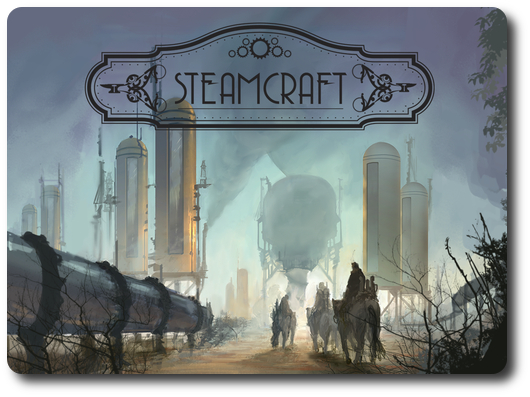
The Basics:
- For ages 8 and up (publisher suggests 12+)
- For 2-4 players
- Approximately 45 minutes to complete
Geek Skills:
- Counting & Math
- Logical & Critical Decision Making
- Reading
- Strategy & Tactics
- Team Play
- Hand/Resource Management
Learning Curve:
- Child – Easy
- Adult – Easy
Theme & Narrative:
- Ruthlessly guide your company to earn wealth or fail and become bankrupt
Endorsements:
- Gamer Geek mixed!
- Parent Geek approved!
- Child Geek approved!
Overview
You have risen through the corporate ranks, stepped on the backs of the bruised, and compromised your own principles to obtain a high-ranking position in the company. Now the Board of Directors has called upon you, a Junior Vice President, to direct a new mining operation. Easy enough, but you soon learn that other companies have the same goal. Time to test your leadership, guile, and executive power.
Steamcraft, designed by Mike Gnade and to be published by Rock Manor Games, will reportedly be comprised of 44 Starting cards, 100 Labor Pool cards, 100 Design Pool cards, 5 Corporation staring decks, 25 “1-Point” Brass cubes, 25 “5-Point” Brass cubes, and 20 Hit Point cubes. As this is a review of a prepublished game, I will not comment on the component quality.
Note: Our copy of the game only supports up to 2 players and did not include all of the Corporation cards. The final version of the game will support up to 4 players – possibly 5 – and include Corporation cards that provide more complex card interaction.
Cranking Up the Boiler
To set up the game, first give each player their Starting cards. This will include 3 “Union Worker” Starting cards, 7 “Clerk” Starting cards, and 1 “Mining Platform” Starting card, for a total of 11 Starting cards. Players place the “Mining Platform” Starting card face-up in front of them (it immediately comes into play). The remaining cards dealt to each player are shuffled and placed face-down in front of them to create their Player draw deck. Any Starting cards not used are returned to the game box.
Second, organize the Corporation cards into 5 decks, with each Corporation deck containing 5 cards belonging to the same corporation. Players select which Corporation deck they want. The selected Corporation deck is placed next to the player. This is referred to as the player’s Reserve draw deck. The player owns their Reserve draw deck and is the only player who can draw from it, but the cards must be purchased first. Recommended Corporate decks have a hexagon symbol next to them. This gives each player the ability to build their own truly unique deck.
Third, take the Building and Unit cards and shuffle them together to form the Design deck. Place the Design draw deck face-down in the middle of the playing area.
Fourth, take the Employee cards and shuffle them together to form the Labor draw deck. Place the Labor draw deck above the Design draw deck, face-down.
Fifth, draw 6 cards from the Labor deck, placing each card face-up and next to the Labor draw deck in the order in which they were drawn. Repeat this same step for the Design deck. The end result should be 6 face-up cards in a row next to the Labor draw deck (referred to as the “Labor Market”) and 6 face-up cards in a row next to the Design draw deck (referred to as the “Design Department”).
Sixth, place 30 Brass cubes per player in a pile. For example, a 3-player game would have 90 Brass cubes. This pile of cubes is referred to as the “Mining Pool”. The amount of cubes can be adjusted to increase or decrease game length.
That’s it for game set up. Each player now draws 5 cards from their Player draw deck (do not draw from the Reserve draw deck) and a first player is selected.
About the Cards
Steamcraft makes use of 4 different card types. Each card type is summarized here.
Employees
The Employee cards represent the player’s general workforce and truly gifted individuals that contribute more than just manual labor. In order to hire Employees, a player must spend Labor and Construction resources. The amount of Brass (victory points) the card is worth at the end of the game is also listed, helping the player determine if the card should be purchased as early as possible or later in the game. Rarity of cards also tells the player how many of that specific Employee card are available in the game (being anywhere from 1, 2, 3, or more). Finally, the effects of the card once played and the Employee’s corporate affiliation is listed.
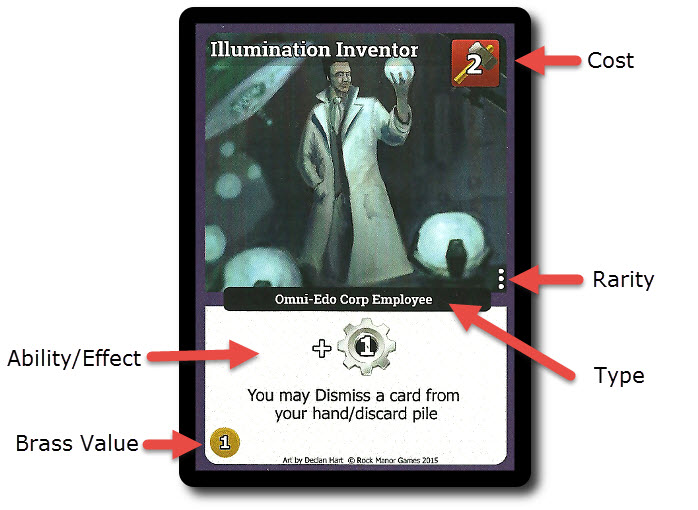
Mining Platform
Each player starts the game with a “Mining Platform” Starting card. These rigs are considered “Buildings” and they can be targeted by opponents, damaged, and even destroyed. This is bad news because players need their “Mining Platform” to create Brass using its conversion rate. Not all buildings are defenseless, however. Some can fight back and are exceedingly difficult to destroy. Players will need to hire Units to defend and protect their assets.
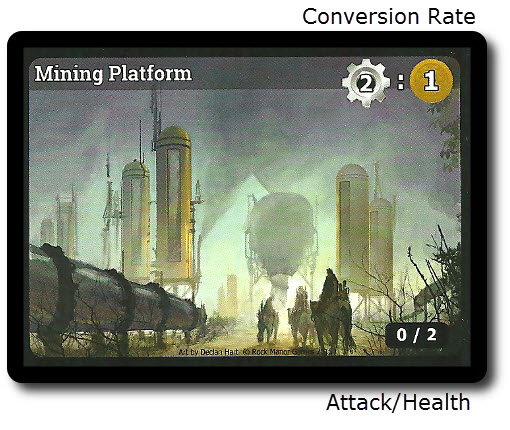
Buildings
Buildings, like the “Mining Platform” Starting card, are permanent structures the player builds that become essential to the growth of the player’s ambitious corporate agenda. Builds come into play face-down, signifying they are being “built”. The “Mining Platform” Starting card is already built and can be used immediately on the player’s turn. After it’s built, the Building card is flipped face-up and can be used. As such, it takes 2 rounds to build and then make use of a Building card. Which is exactly enough time for opponents to figure out how to destroy it. As long as the Building card is face-up and not destroyed, the player can access it. This includes using the Building card for its offensive abilities.
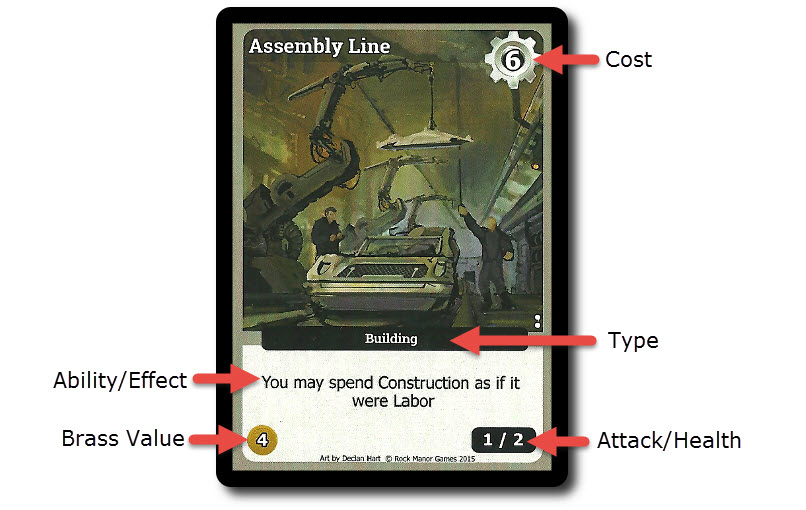
Units
Units represent everyone else the player hires that is not specifically part of the labor force. This includes soldiers, weapons, various vehicles, and different levels of security. When Units are brought into play they are considered “dispatched”, which means they are now in the game, but the player cannot take any action with them until the player’s next turn. When they become active, the player can use them to attack opponents to disrupt their mining operations.
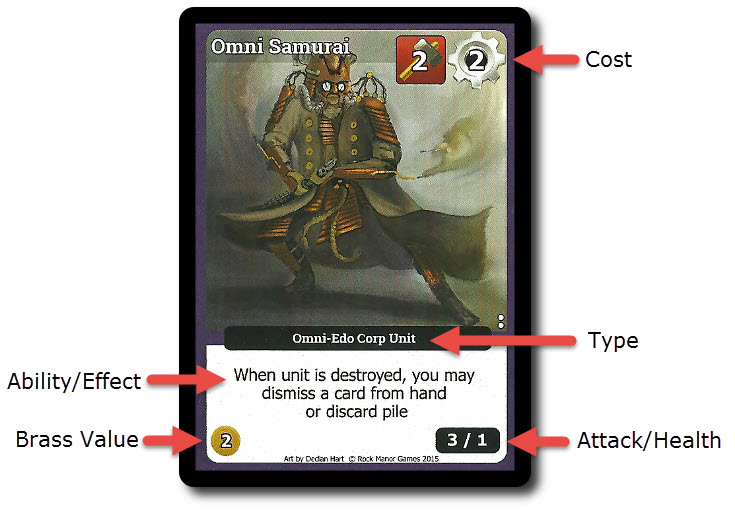
The Power of Steam
Steamcraft is played in turns with no set number of turns per game. A player’s turn is summarized here.
Note: The rules on cards can contradict the basic rules of the game. If such is the case, the rules on the card trump all other rules.
Step 1: Complete Construction
If the player had built any Building cards during their last turn, they now turn them face-up. These Building cards are now available to the player to use this turn.
Step 2: Play Cards
During this step, the player can play cards to purchase new ones and to use them for their effects or abilities.
Purchase Cards
The player now plays cards to acquire the two most important resources in the game. These are Labor and Construction. Cards that require 1 or more of these resources must be paid for using resources provided by other cards, but it never costs the player anything to play a card from their hand once they acquire them.
The player can purchase any face-up cards in the Labor Market and the Design Department rows, pointing out which cards are providing the correct resources and then placing the newly acquired card in their discard pile. When a card is taken from the Labor Market or the Design Department, a new card is immediately drawn to replace it.
The player can also purchase any card from their Reserve deck. Payment is again provided using played cards and the Reserve card is placed in the player’s discard pile.
Use Cards
If a card has an effect or an ability, the player may choose to activate them when the card is played. This is done by announcing the card’s effect or ability and then announcing that target of the outcome. Such effects and abilities include attacking other Unit cards and Building cards. The player must decide if the effect or ability is used at the time the card is played. Meaning, the player cannot play it and then decide later on their turn to activate it.
Some cards have additional conditions that must be met before they are used or have any effect on the game or an opponent.
Step 3: Activate Units
Any Unit cards played during the last turn can now be used. Units can do one the following.
Mine for Brass
Every Unit can be made to mine for Brass, making even really big steam-powered weapons useful during times of peace. A Unit can acquire 1 Brass cube for every 1 Attack power. Brass cubes are taken from the Mining Pool and placed in front of the player. Brass is a limited resource.
Attack
If the player has cards that can attack (have an Attack power of at least 1), they can now attack any Building or Unit that belongs to their opponents. These include those cards that were just brought into play by their opponent and not yet fully activated. Each card can only attack one target, but a single target can be attacked by multiple cards. Combat is simultaneous, meaning both cards attack each other at the same time, dealing damage to each other. If a card’s Health is ever “zero” or less, the card is removed from play and placed in the owner’s discard pile. When a Unit or Building is destroyed, the player responsible for its destruction is given a “1-Point” Brass cube. It’s possible that 2 cards remove each other at the same time, awarding both players “1-Point” Brass cube each.
When a card takes damage, but is not destroyed, the Hit Point cubes are used to keep track of the damage dealt to the card thus far.
Use Ability
If the player likes, they can use the Unit or Building card’s ability. This means the card cannot be used to attack or to mine, but that might be a moot point. Especially if the ability benefits other cards in play or gives the player a tactical advantage.
Step 4: End Turn
The player’s turn is now over. All cards played and any cards still in the player’s hand are discarded except Unit and Building cards. Employee cards are never kept in play unless another card explicitly states it is. The player then draws 5 more cards from the Player draw deck. If the Player draw deck is ever exhausted, the discard pile is shuffled and placed face-down to form the new Player draw deck.
The player’s turn is now over and the next payer in turn order sequence now takes their turn.
Letting Off Steam
The game continues as described above until the Mining Pool is exhausted. As stated earlier, adding and removing the number of Brass cubes during game set up can increase or decrease the game’s length of play.
As soon as the last Brass cube is taken, the game continues for as long as it takes to ensure that all the players have had an equal number of turns. Any additional Brass cubes earned during a player’s turn are taken from the Brass cubes not originally in the Mining Pool.
After each player has finished their turn, the total number of Brass cubes collected are counted. The player then takes their deck of acquired cards and counts the number of Brass cube symbols, where each symbol is worth the points listed on the card. This number is added to the player’s total Brass cubes resulting in their final score. The player with the highest score wins the game.
Game Variants
Several game variants are available to players who want to change the game’s difficulty or would like to play the game differently than the way summarized above.
Customized Corporations
By default, each Corporation deck has a 5 cards designed to go together. These 5 cards are selected to form the player’s Reserve deck. If the players like, they can customize their Reserve deck, creating a unique corporation all their own. Rules are provided to ensure that each Reserve deck is built with limitations, so as not to unbalance the game.
Team Play
Players can work together as a team. Teammates do not attack each other and can purchase cards for one another, placing them in their teammate’s discard pile instead of their own (which is crazy cool). When the game is over, teammates consolidate their wealth to determine their team’s final score.
Battle Mode
This change in the game removes the emphasis on mining and focuses it fully on destruction. Players are no longer looking to beat the competition through savvy business practice. This is a hostile takeover in the most extreme sense. Destroy your opponents, by reducing their labor force and their bank account. The last player in the game wins.
To learn more about Steamcraft, visit the game publisher’s website or visit the Kickstarter campaign.
Final Word
The way the game is set up and the cards are visible to the players helped the Child Geeks learn how to play, discuss options, and make good choices. Not a lot is hidden in this game, which I initially thought would cause something of an information overload with our younger players. Turns out it was just the opposite. The Child Geeks wanted to learn more after seeing the cards, dig deeper into the game, and play it through to see how it would end. They were highly enthused and didn’t even mind when a Building or two was destroyed. According to one Child Geek, “I’ve played harder deck-building games, but this one is fun. It’s easy to play and I like the theme.” A less experienced Child Geek said, “I still don’t know what deck-building is all about, but I do know how all these cards work. It’s easy as soon as you just memorize what the symbols mean.” Seeing that there are only 3 of interest, memorizing the symbols never took long. Nor did the games. When all the Brass was collected and only one corporation remained, all the Child Geeks thought Steamcraft was a winner.
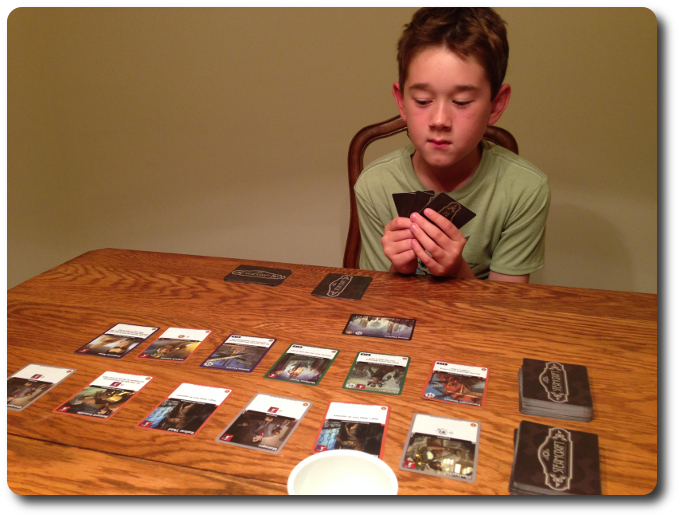
A Child Geek ponders the cards to be taken, while his opponents impatiently wait…
The Parent Geeks who had played many deck-building games found Steamcraft to be entertaining, but not overly surprising. According to one Parent Geek, “A lot of what these cards do is what I’ve already seen in other games. That makes it real easy to lean and even easier to play.” Lack of unique game play and card abilities didn’t bother the Parent Geeks in the slightest, but they hoped that future cards for the game would introduce more interesting abilities and effects. The non-gamers and very casual Parent Geeks also had no problem learning how to play and enjoyed the results of their efforts. As one non-gamer put it, “I have no idea what this game is about…space cowboys or some other nonsense…but the game is fun.” When the last card was played, all the Parent Geeks voted to approve Steamcraft.
For the Gamer Geeks, it came down to the game’s depth. Almost every Gamer Geek felt the game was designed well enough and played smoothly, but only about half felt that the game had enough depth of play to be worthy of their elitist gaming table. According to one Gamer Geek, “I don’t feel like this game is doing anything new. It plays like all the other deck-building games I have played. The game isn’t bad, but it doesn’t excite me at all.” Another Gamer Geek said, “This would be a great game to put in front of a casual gamer if they had never played a deck-building game before. It has a good theme and is easy to teach, but it’s not a game that would keep me interested for very long.” Not every Gamer Geek agreed however. One Gamer Geek said, “I don’t like that we [Gamer Geeks] always judge a game on how difficult it is. Sometimes I want a game that is easier to play. This is not a hard game unless you are playing against a really good opponent. Even then, the game is fun to play and keeps game play light.” When all the corporations were done mining, the Gamer Geeks could not decide, giving Steamcraft a mixed level of approval.
What turned away some of the Gamer Geeks, was a real draw for casual gamers and new players just learning the game. The cards do not have what I would consider overly complex or game changing abilities and effects. They are fairly utilitarian in design, providing the player more resources, the ability to trash cards, and opportunities to gain new ones. Essentially, all the most basic of abilities, effects, and special actions we have long since come to expect in all of our deck-building games.
Steamcraft hit the unfortunate hurdle of being a new game to a very old race. The Gamer Geeks have watched the deck-building games evolve, grow, and become exceeding complex in some cases. Steamcraft came across as commonplace and uninteresting for those who are used to building decks with lots of combos and multifaceted card interactions.
It’s the game’s level of simplicity that allowed our new players and casual gamers to really enjoy it. The demand on the player is just enough to keep them engaged and challenged, but not crushed by the weight of hindsight that comes only when you realize you are building your deck wrong. Make no mistake, Steamcraft is not a game you can win with your eyes closed, but it’s a game that allows even the most novice of players an opportunity to learn the basics of deck-building and then excel at it.
The hobby is awash with deck-building games nowadays and one could argue the point that one more is not needed. But there is always room for more games because more games means more fun. Steamcraft offers its players an opportunity to take on the role of a corporate executive in a steampunk fantasy world. That’s unique enough in its own right to raise eyebrows. The game feels competitive from the very start and it’s very satisfying to bring out Buildings and Units that hinder the business success of your opponents using calculated strikes and hording resources. If you are new to deck-building games or enjoy casual games in general, then do sit down and play Steamcraft.
This is a paid for review of the game’s final prototype. Although our time and focus was financially compensated, our words are our own. We’d need at least 10 million dollars before we started saying what other people wanted. Such is the statuesque and legendary integrity of Father Geek which cannot be bought except by those who own their own private islands and small countries.



